One of my favorite things about talking with members of my ‘Building Your Foundation’ Program is that I constantly learn about new products and finishes that weren’t available (or at least weren’t popular) when I built my home back in 2013. Recently I learned about porcelain countertops and, as always, I dug right into researching and learning all about this particular finish … and I’m sharing everything I learned below :).
If you’ve heard about porcelain countertops and you’re curious about what they are and if they might be a good fit for your home, you’ll find this (in-depth) overview of porcelain countertops (complete with pros and cons) very helpful.
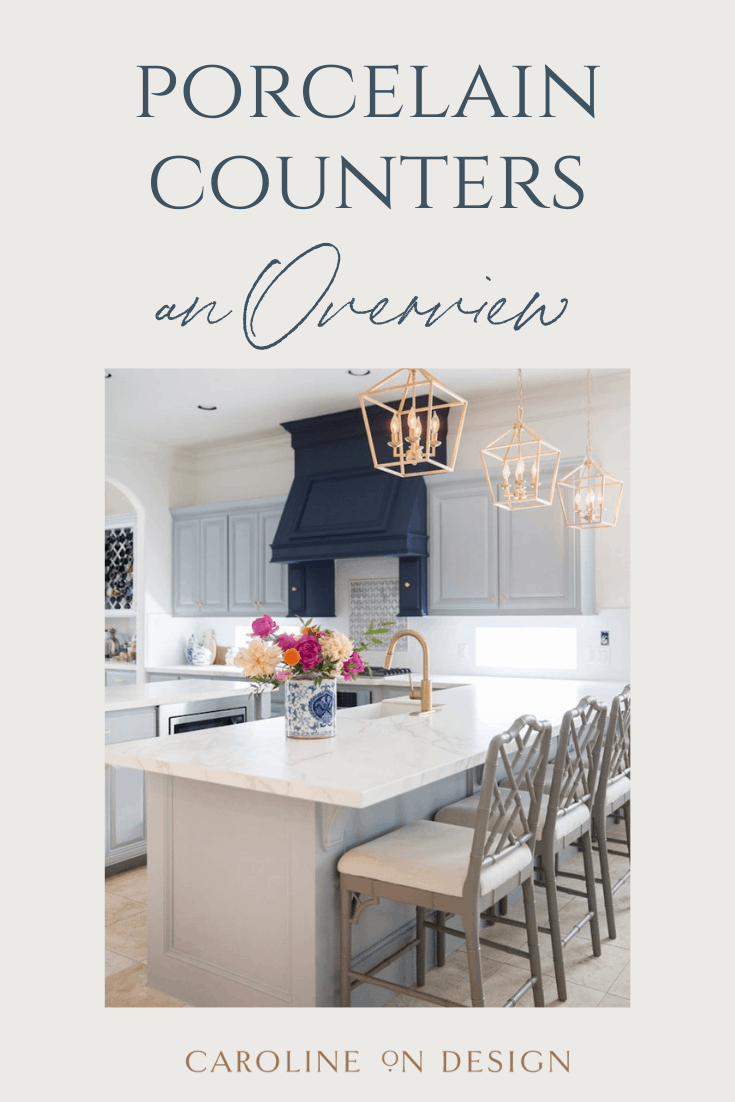
WHAT ARE PORCELAIN COUNTERTOPS?
While porcelain countertops are only recently gaining popularity in the US, they have been used in Europe for several years now.
Porcelain is a man-made product created from a clay called ‘China clay’ and it is a combo of a mineral called Kaolinite, along with Silica, Feldspar, and other minerals that work together to create the strength and durability of porcelain.
This combination of materials is put into a kiln together and fired at extremely high temps … which results in a dense material that is very strong, almost fully impervious to stains, heat, UV rays, scratching, chips and cracks.
During porcelain countertop manufacturing, pigmented glazes are added to create different patterns and colors on the porcelain slab. Porcelain can be either glazed or unglazed. However, glazing increases the durability of the slab, while also creating a shiny finish and decreasing porosity (which means a decreased risk of staining).
DRAWBACK OF PORCELAIN COUNTERS
One of the major drawbacks to glazed porcelain is that the pattern or color is only printed on the surface and does not go through the entire body of the slab or tile. This means that the interior color may be a different color which becomes a problem if the surface is chipped (because the differing interior color will show).
Unglazed porcelain, on the other hand, has the same color on both the surface and the interior of the slab.
PORCELAIN COLOR + PATTERN AVAILABILITY
Like many other countertops, porcelain countertops are available in a wide variety of colors and patterns that resemble natural elements (e.g. marble, wood grain, concrete).
But remember … the pattern and color will not be on the interior of the slab because it is only applied to the top surface of the counters during glazing.
PORCELAIN COUNTER (LIMITED) EDGES
Porcelain countertops are unique when it comes to the edges. Since the patterns and colors in porcelain are only printed on the surface, edge styles are more limited than with natural stone or quartz. Cutting a rounded edge, for example, would remove the pattern. So most people opt for a simple square edge to preserve the surface pattern and color.
PORCELAIN COUNTER DURABILITY
Although extremely durable once installed, porcelain slabs can be quite lightweight and thin. The typical thickness of porcelain countertops is ¼ inch (6 mm) or ½ inch (12 mm). Also, it can be manufactured in very large slabs that are roughly 126” x 62”. This allows one slab to cover an entire island without the need for seams.
Due to the thinness of porcelain countertops, they can be installed directly over your existing countertops if you are doing a kitchen (or bathroom) remodel. This, of course, is a bonus, BUT there is one problem when it comes to how thin porcelain is …
The full-sized slabs are delicate to cut and work with, so it can be difficult to find a countertop fabricator that is willing to install a porcelain slab. The thin slabs can crack more easily than granite or marble during fabrication, so many fabricators don’t enjoy working with porcelain.
Once installed, however, porcelain is extremely hard and durable. Cracking is only a big issue during the handling, moving, and cutting of very large slabs.
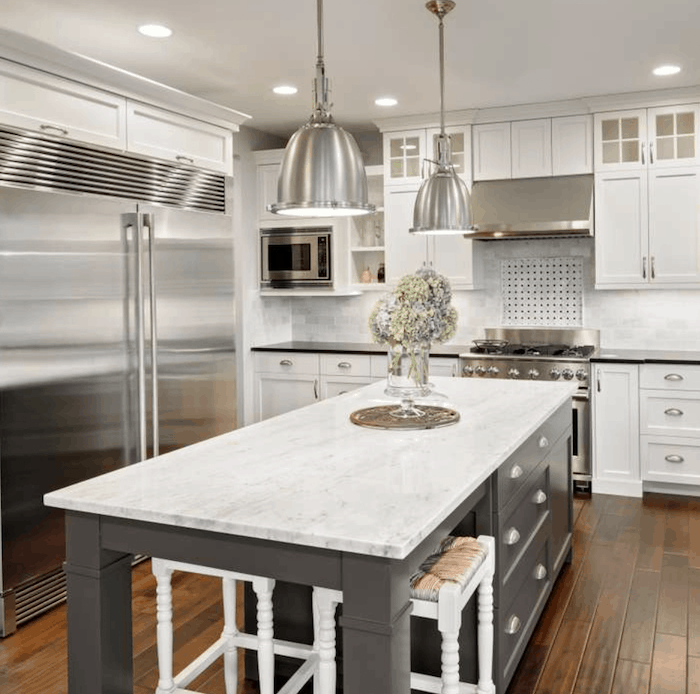
Image via PRECISION STONE DESIGNS
HOW MUCH DO PORCELAIN COUNTERTOPS COST?
Porcelain countertops range in price from $55 – $120 per square foot (including installation). Like with any counter product, the final price is affected by many factors, including the color, pattern, texture, and edge style, as well as how complex the installation process is.
In comparison to granite and quartz, porcelain falls below the average price of both of these other countertop options. Granite countertops range from $45-$200 per square foot (installed) and quartz countertops range from $75-$150 per square foot (installed).
Obviously, the large range of costs for all three countertop options is dependent on the level of product you choose. It’s important to note that porcelain tiles are significantly less expensive than a large porcelain slab.
ARE PORCELAIN COUNTERTOPS FRAGILE?
As mentioned above, porcelain countertops are quite fragile during the fabricating process, so it’s difficult to find a fabricator willing to work with porcelain.
Once installed, however, porcelain is very hard and durable, so they are not considered fragile at this point. Cracking is rarely an issue after the countertops are installed.
DO PORCELAIN COUNTERTOPS CHIP EASILY?
Porcelain countertops are highly durable once installed … BUT, they are not indestructible. It’s best to treat porcelain countertops with care and use a cutting board when chopping and slicing.
Chips, cracks, and scratches are usually noticeable given that the pattern and color are only on the surface. One caveat is if you choose solid color porcelain with no pattern, the color inside the slab will be the same as the surface, so chips and cracks aren’t nearly as noticeable.
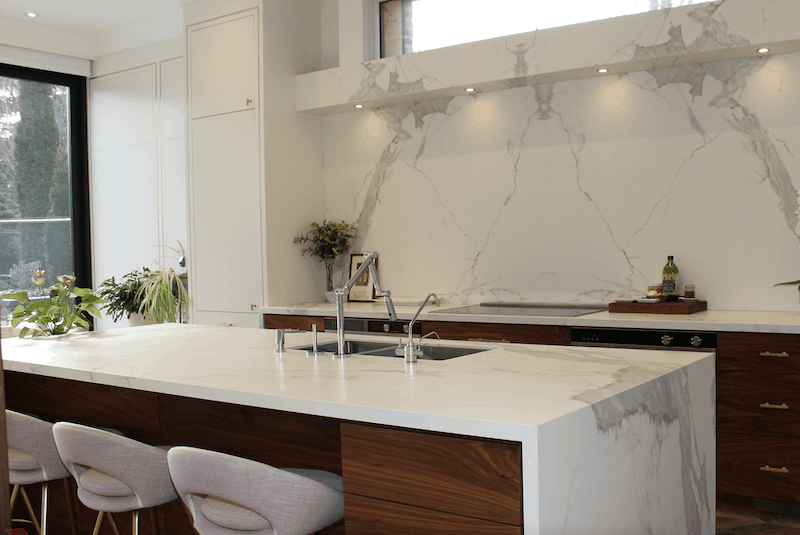
Image via MAXSPACE STONE WORKS
DIFFERENCE BETWEEN PORCELAIN AND QUARTZ?
Let’s start with what is the same about porcelain and quartz countertops … they are both manmade products (i.e. not natural stone). So what’s different? Let’s take a look …
DURABILITY
While porcelain slabs are quite hard and durable (after installation), quartz is slightly harder and more durable.
AESTHETICS
Both porcelain and quartz can be manufactured in a wide variety of colors and patterns to mimic patterns found in nature (e.g. marble). However, quartz patterns have an edge over porcelain in terms of chipping, cracking, or scratching.
As mentioned above, porcelain slabs will show a different interior color if chipped so any chips will be noticeable. This isn’t the case with quartz countertops.
PRICE
Quartz is the more expensive option for both material and installation. Plus, quartz requires a more intricate installation process as compared to the installation of a porcelain slab.
MAINTENANCE
Both quartz and porcelain countertops are non-porous and are resistant to acidic liquids. However, porcelain does have an edge over quartz because it is slightly more resistant than quartz. Both are very easy to keep clean and neither option requires re-sealing.
DIFFERENCE BETWEEN PORCELAIN AND GRANITE?
The biggest difference between porcelain and granite is that granite is a natural stone (i.e. found in nature) whereas porcelain is a manmade product.
DURABILITY
Porcelain slabs and granite are both extremely durable products and both have good resistance against chips, cracks, and scratches. However, granite is much stronger in terms of cutting directly on the surface.
It is highly recommended to use a cutting board when using knives on porcelain countertops. Also, granite has a slight edge in terms of heat resistance. Although, porcelain is able to resist heat as well.
AESTHETICS
Since granite is a natural stone, you are limited to patterns found in nature. There is less variety than porcelain (which can be manufactured in many colors and patterns), but you do run the risk of cracks and chips in porcelain being very noticeable as the interior color of the slab typically varies from the surface color and/or pattern.
PRICE
Porcelain is typically less expensive than granite in terms of both material and installation costs.
MAINTENANCE
Granite and porcelain countertops are both very easy to keep clean. However, granite does require periodic resealing of the surface; porcelain does not.
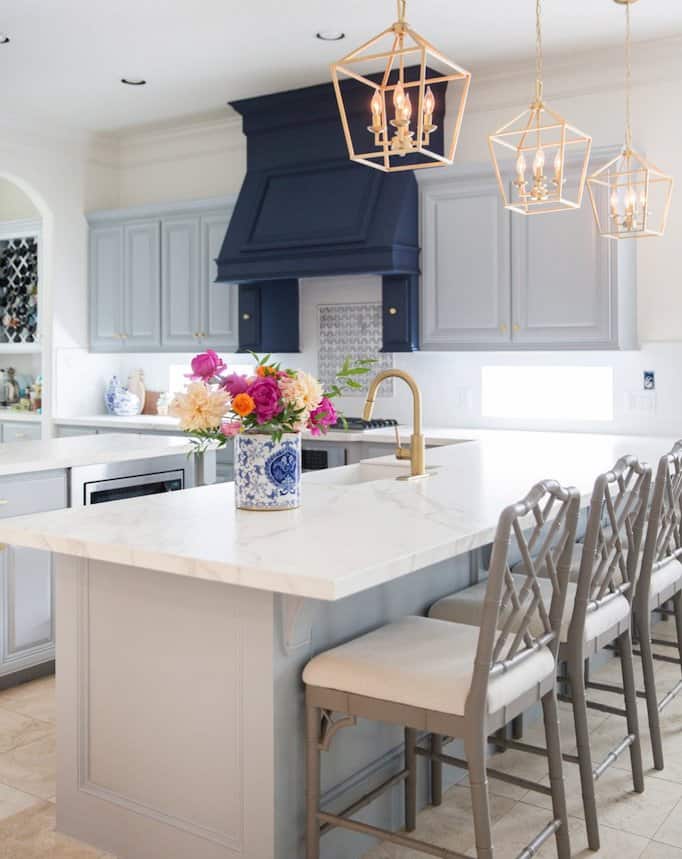
Image via CAKE AND CONFETTI
PORCELAIN COUNTERTOP PROS + CONS
PORCELAIN COUNTERTOP PROS
- Porcelain countertops are heat resistant and can handle a hot pot or pan directly on the surface (although I always recommend using a hot pad or trivet, just in case!)
- Porcelain is hard and extremely durable (once installed)
- Porcelain is scratch-resistant (except to ceramic knives)
- Porcelain is non-porous (i.e. it doesn’t absorb liquids) and stain-resistant which means sealing is typically not necessary
- Porcelain is easy to clean and maintain
- Porcelain has a wide variety of color and pattern choices to choose from
- Porcelain is UV light resistance, so direct and prolonged sunlight exposure won’t discolor porcelain countertops
- Porcelain is environmentally friendly
- Porcelain countertops can be installed directly over existing countertops
- Porcelain countertops are economically priced with slabs/installation ranging between $55 to $120 per square foot (which is lower than both quartz and granite countertops)
- Porcelain will not etch or dull from acidic foods (like marble does)
PORCELAIN COUNTERTOP CONS
- Porcelain can be easily damaged during fabrication, moving, and installation
- Porcelain can chip, scratch, or crack from blunt force
- Although relatively scratch-proof, ceramic knives can damage porcelain countertops
- When porcelain is chipped or broken, the chip can be very noticeable as the pattern is only printed on the surface and does not carry through into the interior of the slab
- There are limited edge options for porcelain due to the interior of the slab showing a different color if the edges are cut to be just about anything other than square edges
- It can be difficult to find someone qualified to fabricate and/or install porcelain countertops
Ok, how was that for a (very) lengthy overview of porcelain countertops?! Hopefully, you now feel like you know enough about porcelain countertops to decide if this option might be a good fit for your new home (or kitchen remodel).
Obviously, I can’t answer this question for you (i.e. whether or not porcelain is the best option for your kitchen). However, you can download my *FREE* Design Decision Guided Worksheet to walk you through making this decision, as well as every other design decision for your home!
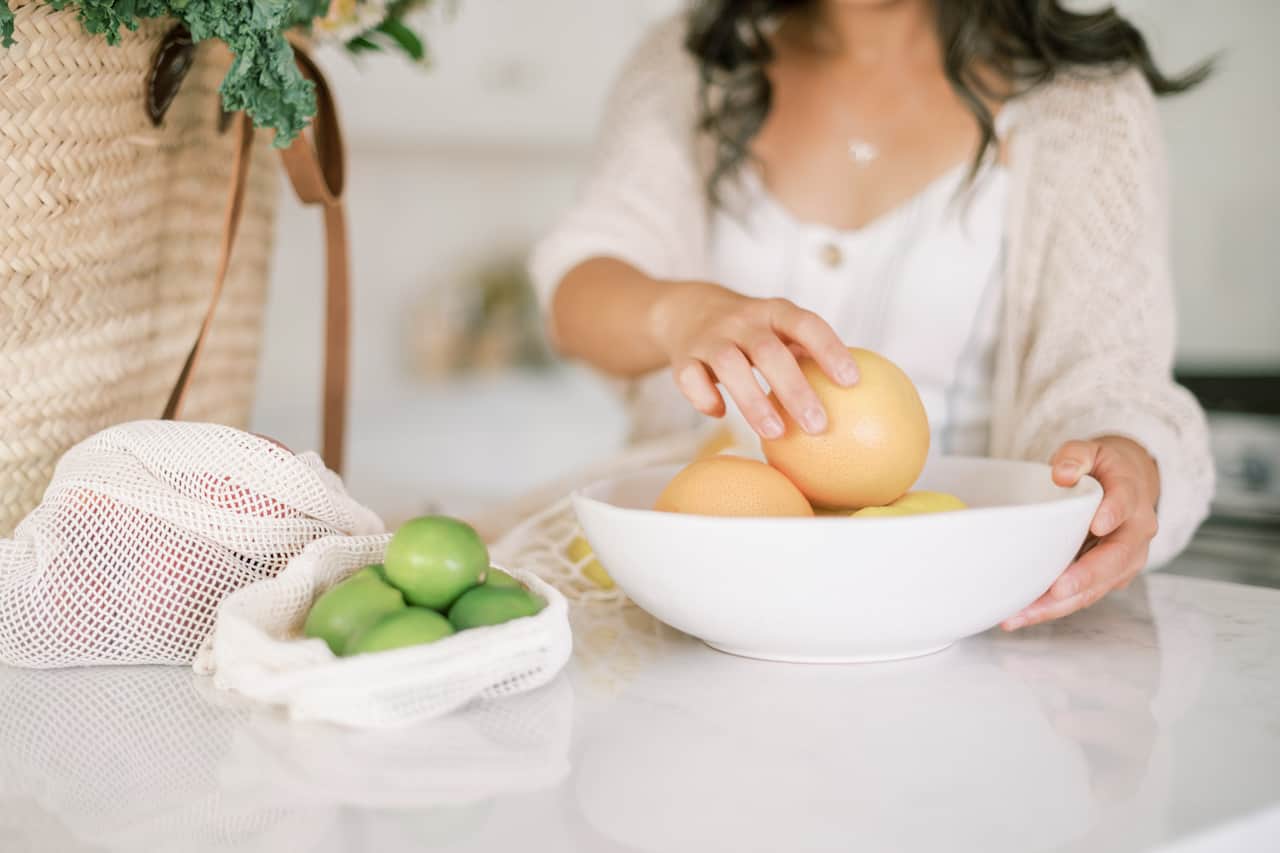
Wow! Who knew? Still learning every day what is new out there (porcelain countertops is a thing?). You really did your homework! Very well-written, informative, interesting…and thorough!!! Thank you for doing the research and for taking the time to share your knowledge!
Glad you found this post helpful, Allison! In full disclosure, I didn’t know porcelain countertops existed until recently :).
I renovated my kitchen 16 years ago. I used 12×12 porcelain tiles on the floor and counter tops. I LOVE my countertops!! I put pots straight from the stove and broiler pans straight from the oven on them with no problem. I cut and dice on them. I clean the area where I do most of my food prep with a mixture of water and bleach. There is a double window that gets afternoon sun over this section. The color of the tiles looks just the same as when they were installed. I know because I have a box stored away and recently compared them to the installed ones. I’m moving and renovating another house to live in. My new kitchen will have porcelain tiles for the countertops. This time I’m using 24×24.
Thank you so much for sharing your experience, Camille! It helps other readers to hear from someone who loves their porcelain counters :).
[…] however, thin porcelain slabs can be difficult to work with and crack and break easily, making it difficult to find a fabricator to work with the product. Like laminate, porcelain’s design features are printed on the […]
I am interested in induction stove top that is installed under the porcelin counter. It is regularly done in Europe. Any idea of the cost? It would allow a smooth, appliance free island top for buffets, etc. When not cooking.
Hi Sue! I am not familiar with the cost of induction stove tops. I would talk to an appliance retailer and/or expert.